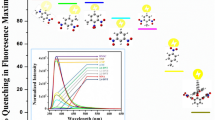Abstract
The interaction of 9-diphenylaminoacridine dye (indicator) with several small analyte molecules (methanol, acetonitrile, acetone, tetrahydrofuran, benzene, ammonia, formaldehyde, and acetaldehyde) has been theoretically studied in relation to the problem of the development of optical chemosensors based on organic dyes. The structures of the resulting complexes and the absorption spectra of 9-diphenylaminoacridine and its complexes with analytes were calculated using density functional theory (DFT) with the PBE0 functional and the 6-31G(d,p) basis set. It was demonstrated that complexes of two types with different mutual arrangements of molecules corresponding to the lateral and stacking structures can be formed for each analyte. The calculated absorption spectrum only weakly changes upon complex formation, which is in agreement with experimental data on the absorption spectra of 2,7-dimethyl-9-ditolylaminoacridine in solutions of corresponding solvents. The method for the calculation of excited states that was used in this work can be applied to the calculation of the fluorescence spectra of 9-diphenylaminoacridine complexes.
Similar content being viewed by others
References
Albert, A., The Acridines: Their Preparation, Physical, Chemical, and Biological Properties and Uses, London: Edward Arnold, 1966.
Goodell, J.R., Svensson, B., and Ferguson, D.M., J. Chem. Inf. Model, 2006, vol. 46, p. 876.
Ito, F., Kakiuchi, T., and Nagamura, T.J., Phys. Chem. C, 2007, vol. 111, p. 6983.
Mosurkal, R., Hoke, L., Fossey, S.A., Samuelson, L.A., Kumar, J., Waller, D., and Gaudiana, R.A., J. Macromol. Sci. Pure Appl. Chem., 2006, vol. A43, p. 1907.
Murza, A., Sanchez-Cortes, S., Garcia-Ramos, J.V., Guisan, J.M., Alfonso, C., and Rivas, G., Biochemistry, 2000, vol. 39, p. 10557.
Yang, Y.-K. and Tae, J., Org. Lett., 2006, vol. 8, no. 25, p. 5721.
Sazhnikov, V.A., Strukov, A.G., Stunzhas, M.G., Efimov, S.P., Andreev, O.M., and Alfimov, M.V., Dokl. Akad. Nauk SSSR, 1986, vol. 288, no. 1, p. 172.
Sazhnikov, V.A., Ait, A.O., Baskiin, I.I., and Alfimov, M.V., Abstract of Papers, XX Int. Conf. on Photochemistry, Moscow, 2001, p. 469.
Sazhnikov, V.A., Khlebunov, A.A., and Alfimov, M.V., Khim. Vys. Energ., 2007, vol. 41, no. 1, p. 38 [High Energy Chem., 2007, vol. 41, no. 1, p. 25 ]
Sazhnikov, V.A. and Alfimov, M.V., Chem. Eng. Trans., 2006, vol. 15, p. 267.
Jacquemin, D., Perpete, E.A., Scuseria, G.E., Ciofini, I., and Adamo, C., J. Chem. Theory Comput., 2008, vol. 4, p. 123.
Granovsky, A.A., PC GAMESS/Firefly, version 7.1.F. www.http://classic.chem.msu.su/gran/firefly/index.html.
Author information
Authors and Affiliations
Corresponding author
Additional information
Original Russian Text © A.A. Safonov, A.A. Bagaturyants, V.A. Sazhnikov, M.V. Alfimov, 2011, published in Khimiya Vysokikh Energii, 2011, Vol. 45, No. 3, pp. 260–267.
Rights and permissions
About this article
Cite this article
Safonov, A.A., Bagaturyants, A.A., Sazhnikov, V.A. et al. Density functional calculations of 9-diphenylaminoacridine fluorescent indicator and its interactions with analyte molecules: I. Structures of complexes in the ground electronic states and absorption spectra. High Energy Chem 45, 229–236 (2011). https://doi.org/10.1134/S0018143911030131
Received:
Published:
Issue Date:
DOI: https://doi.org/10.1134/S0018143911030131




